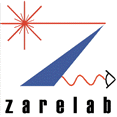Quantum control of molecular collisions near 1 kelvin
William Edward Perreault and Nandini Mukherjee
Measurement of vector correlations in molecular scattering is an indispensable tool for mapping out interaction potentials. We study molecular collisions such as the rotationallyinelasticscattering of deuterium hydride (HD) (v= 1, j= 2) by molecular deuterium (D2) to form HD (v= 1, j= 1),1where v and j are the vibrational and rotational quantum numbers, respectively. HD (v= 1, j= 2) is prepared using Stark-induced adiabatic Raman passage (SARP), an optical adiabatic passage technique developed inour lab which uses two partially overlapping single-mode, nanosecond pulses to coherently transfer nearly upwards of 90% of the population in a molecular ground state to an addressable excited state.2Bychanging the polarization of the laser light used to perform SARP, the orientation of the excited molecule can be controlled.3This allows us to prepare excited HD (v= 1, j= 2) with its bond axis aligned preferentially parallel or perpendicular to the lab-fixed molecular beam axis(seeFig. 1). By coexpanding pairs of gases in a single supersonic beam, we achievecollision temperatures near 1 kelvin, restricting scattering to a few lowestpartial waves, such as(l=0)sand(l=1)p. This allows us to use partial wave analysis based on the conservation of angular momentum to obtaininformation about the scattering potential. In our recent work on the rotationally inelastic scattering of HD (v= 1, j= 2) by D2to form HD (v= 1, j= 1),1the scattering angular distributions showed a dramatic stereodynamic preference (~3:1) for perpendicular versus parallel alignment as can be seen in Fig. 2. The four-vector correlation measured between the initial and final velocities and the initial and final rotational angular momentum vectors of HD provides insight into the strong anisotropic forces present in the collision process.

Figure1.The quantum state of HD is prepared using SARP optical fields polarized (a) parallel, in H-SARP, and (b) perpendicular, in V-SARP, with respect to the molecular beam axis. For H-SARP, the m-state refers to the quantization Z-axis parallel to the relativevelocity of HD and D2. For V-SARP, the m′ state refers to the quantization Z′ axis perpendicular to the relative velocity.

Figure2.Collisions of state-prepared HD (v= 1, j= 2) with unprepared D2forming HD (v= 1, j= 1), where the HD molecular bond axis was aligned (a) parallel or (b) perpendicular to the relative velocity between HD and D2. The purple dashed curve gives the time-of-flight distribution of unscattered state-prepared HD (v= 1, j= 2). In both (a) and (b),the black solid curve shows fitting using partial wave analysis.See Ref. [1] for more details.
2. W. E. Perreault, N. Mukherjee, and R. N. ZareJ. Chem. Phys.145, 154203(2016).
3. N. Mukherjee, W. Dong, and R. N. Zare, J. Chem. Phys.140, 074201 (2014).
